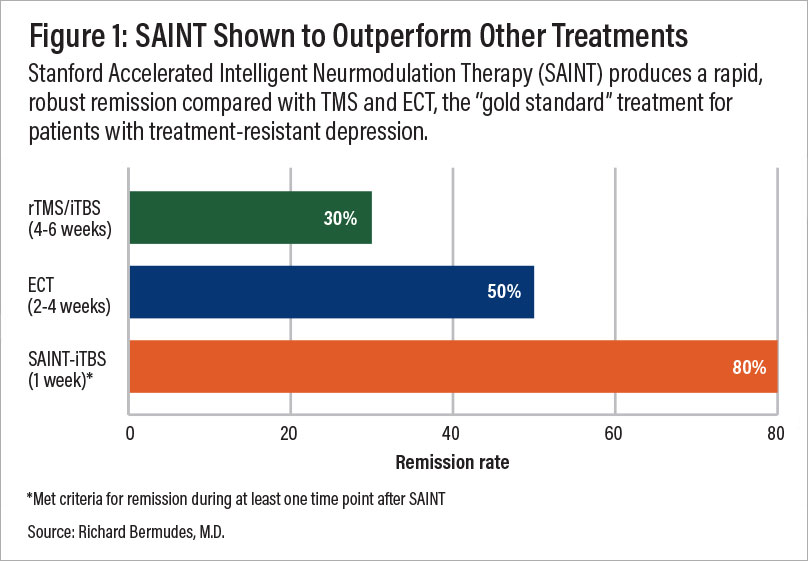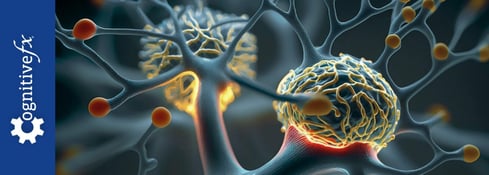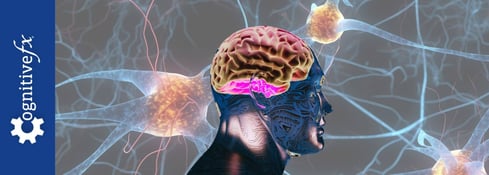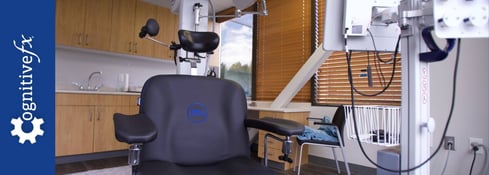What If TMS Doesn’t Work? Advice for Patients
If you’re wondering what to do when transcranial magnetic stimulation (TMS) doesn’t work, you might be:


In general, increased anxiety is not a common side effect of transcranial magnetic stimulation (TMS), though some patients have experienced a temporary increase in anxiety during or after treatment.
If you're considering TMS therapy, you may wonder if this is something to be concerned about. Are there ways to reduce the risk of increased anxiety or strategies to support you if it happens?
In this article, we address these questions to help you determine whether TMS is the right treatment for you.
Below, we cover:
TMS rarely increases or triggers anxiety symptoms in most patients. However, some may experience anxiety symptoms in certain situations.
Choosing TMS therapy requires time, financial commitment, and emotional energy. Many patients considering TMS have already spent years trying antidepressant medications and other treatments with limited success. As a result, TMS can feel like their last hope for relief, and the uncertainty of whether it will work may understandably trigger feelings of fear or anxiety.
Some patients may also feel uneasy about the treatment itself. While TMS is a completely painless and non-invasive treatment, the concept of brain stimulation with magnetic fields might feel intimidating. Common side effects, like occasional headaches, lightheadedness, scalp discomfort, or facial muscle twitching, are short-lived and manageable. Serious side effects, such as seizures, are extremely rare, with no evidence of long-term harm.
If you’re feeling apprehensive, know that it’s natural. Most patients report significant improvements with TMS and few, if any, unpleasant side effects. Increased anxiety is not recognized as a side effect of TMS therapy.
Patients may experience a temporary worsening of symptoms during the first few weeks of TMS treatment, known as a TMS dip. In some cases, this may be due to hypervigilance to normal emotional fluctuations, which is common in many psychological treatments. For example, a patient undergoing TMS treatment may start paying more attention to their anxiety, which can lead to increased worry about their symptoms and an upward spiral of anxiety.
While this dip can feel concerning, it’s a normal and temporary part of the process for some individuals. Symptoms typically improve as treatment progresses, bringing relief over time.
In more extreme cases, your doctor may lower the treatment intensity for a few sessions to help manage anxiety. However, for most patients, these symptoms resolve naturally without needing adjustments to the treatment protocol.
It’s important to note that TMS isn’t the only treatment for depression that can cause a temporary dip. Many patients starting antidepressant medications experience a similar effect, where symptoms might worsen initially or unpleasant side effects occur before improvement sets in.
If you’re experiencing increased anxiety or a dip during TMS, don’t hesitate to talk to your doctor. They can provide guidance, adjust your treatment if necessary, and help you manage symptoms. Staying consistent with your sessions is key, as the dip is usually temporary, and treatment is most effective when completed as prescribed.
TMS is an effective treatment for conditions like major depressive disorder and anxious depression when patients have been accurately diagnosed. However, in cases where a patient has been misdiagnosed or has an undiagnosed condition that TMS is not approved to treat — such as bipolar disorder, schizophrenia, or other mental health disorders — there is a risk that anxiety symptoms may worsen.
For example, studies show that patients with bipolar disorder may react differently to TMS depending on the treatment site. Stimulation of the left prefrontal cortex has been linked to increased symptoms, whereas treatment on the right side has shown significant improvement. This highlights the complexity of using TMS for conditions outside its approved indications. Evidence regarding TMS for bipolar disorder remains inconclusive, and further studies are needed.
Similarly, research on TMS for schizophrenia has yielded mixed results. Some symptoms, such as difficulties with speech or emotional expression, showed slight improvement. However, other symptoms, including delusions and hallucinations, worsened in some cases, potentially triggering increased anxiety.
These findings underscore the importance of a thorough and accurate diagnosis before starting TMS. If you’re considering TMS therapy, ensure your doctor has ruled out conditions like bipolar disorder, schizophrenia, or other mental health conditions, which may respond differently to TMS treatment. A comprehensive evaluation by a qualified mental health professional is critical to determine whether TMS is the right option for you.
While there is no direct evidence to support this, one possible explanation for why some patients experience anxiety symptoms during TMS therapy is the improper placement of the magnetic coil.
For TMS to be effective, the magnetic coil must target an area of the brain called the dorsolateral prefrontal cortex (DLPFC). This region plays a crucial role in mood regulation and is often affected in individuals with depression. Low activity in the left DLPFC, which is linked to feelings of positivity and reward, is particularly common in depression. Proper stimulation of this part of the brain can help restore normal activity levels and reduce depressive symptoms.
However, pinpointing the exact location of the DLPFC can be inconsistent, depending on the method used. The original and most common type of TMS — repetitive transcranial magnetic stimulation (rTMS) — relies on the "5 cm method," which manually measures distances between the patient’s nose, ears, and the top of the head.
Due to variations in head size, shape, and individual brain structure, this approach can be imprecise. Even a slight deviation from the left DLPFC — by just a few millimeters — could reduce treatment effectiveness and potentially cause unintended effects, such as anxiety symptoms.
Fortunately, advancements in TMS technology, such as neuronavigation (which we’ll cover below), now allow for more accurate coil placement to deliver the magnetic pulses, reducing the likelihood of imprecise targeting. If you’re considering TMS therapy, don’t hesitate to ask your healthcare provider about their targeting methods to ensure the best possible outcomes.
The likelihood of developing significant anxiety symptoms as a result of TMS treatment is low. Even if you experience mild anxiety due to concerns about the treatment’s effectiveness or temporary symptom dips, it’s important to note that there is no evidence linking TMS to severe or long-term anxiety disorders.
In fact, emerging research suggests that TMS may help reduce anxiety symptoms in certain patients. For example, a preliminary study reported over a 70% reduction in anxiety symptoms among individuals with occupational stress and generalized anxiety disorder. Nearly 80% of participants responded positively to treatment, and about 33% achieved full remission. Notably, these improvements were sustained for at least three months after treatment.
TMS is also approved to treat patients with anxious depression — a condition involving both depression and anxiety symptoms. In one study, after completing at least 20 TMS sessions, approximately 50% of patients experienced reductions in anxiety symptoms, and 30% achieved remission. Many patients reported feeling better shortly after starting treatment, with benefits lasting for months.
While TMS has not yet been FDA-approved solely for anxiety disorders, its approval for anxious depression demonstrates its potential for treating anxiety symptoms in combination with symptoms of depression.
One example of TMS approved for the treatment of anxious depression is called deep TMS, which you can learn more about here.
If you’re concerned about anxiety during or after your TMS treatment plan, rest assured that the risk is minimal, and the evidence points to its effectiveness for managing anxiety in specific cases.
Patients who are experiencing anxiety symptoms during or after TMS may benefit from psychotherapy to help them cope.
Among psychotherapy approaches, cognitive behavioral therapy (CBT) is the most supported by evidence as a treatment option for anxiety disorders. Unlike medication, CBT addresses more than just symptoms. It helps patients uncover the underlying causes of their worries, modify cognitive processes, and develop better ways to face challenges and stressors. Since anxiety disorders vary, psychologists and other healthcare providers delivering CBT must tailor their sessions to the patient’s specific symptoms.
The length of therapy depends on the type and severity of the symptoms, with many patients seeing significant improvement after 8–16 weeks of weekly CBT sessions.
Advancements in technology now offer a more accurate alternative for targeting the dorsolateral prefrontal cortex (DLPFC), helping to reduce the risk and minimize potential side effects from TMS.
Specifically, functional MRI (fMRI) can be used to map brain activity and pinpoint the exact location of the DLPFC for each patient. Combined with neuronavigation technology, the magnetic coil can be precisely placed over the target area during every treatment session. Unlike the manual placement method used in standard TMS, this approach minimizes variability and improves treatment outcomes.
This protocol, known as SAINT TMS or fMRI-guided TMS, is now considered the gold standard treatment for treatment-resistant depression.

A comparison of remission rates for rTMS/iTBS, electroconvulsive therapy (ECT) & SAINT-iTBS.
Not only is fMRI-guided TMS less likely to trigger anxiety symptoms, but it also produces significantly higher success rates than previous TMS methods.
In a double-blind randomized clinical trial, about 86% of patients responded to the SAINT treatment, and around 79% reached remission. All participants had treatment-resistant depression and had failed at least two other depression treatments.
One month after treatment, 60% were still in remission. In comparison, about 50% of patients respond to rTMS, with just over 30% achieving remission.
Furthermore, SAINT TMS works quickly. In contrast to rTMS, which takes four to six weeks of treatment, SAINT TMS is completed in just one week, often producing rapid antidepressant effects for patients.
The main challenges for patients are accessibility and affordability. Currently, fewer than ten clinics in the US offer SAINT treatment. And the ones that do charge $30,000+ for treatment.
Our team at Cognitive FX, based in Provo, Utah, provides an alternative to SAINT TMS that offers the same precision of personalized treatment targeting, combined with FDA-approved theta burst stimulation at a significantly lower cost. This approach delivers the same core elements that make SAINT so revolutionary.
The only difference between our treatment and SAINT (a trademark licensed to Stanford Medical) is our targeting method. Our target locations are determined by fMRI and our prescribing neuroscientist and physician, rather than their proprietary software.
| Accelerated fMRI - TMS | Magnus SAINT™ TMS | |
|---|---|---|
| FDA-Approved iTBS | ✔ | ✔ |
| FDA-Approved Neuronavigators | ✔ | ✔ |
| FDA-Approved Figure 8 Coils | ✔ | ✔ |
| Number of Treatment Days | 5 | 5 |
| Treatments per Day | 10 | 10 |
| Total Treatments | 50 | 50 |
| Number of TMS Pulses | Approx. 90,000 | 90,000 |
| Resting motor threshold pulse intensity | 90–120% | 90–120% |
| FDA-Approved Personalized DLPFC Targeting | ✘ | ✔ |
| Personalized DLPFC Targeting Assists Doctor in Target Location | ✔ | ✘ |
| Personalized E Field Coil orientation | ✔ | ✘ |
| Cost | $9,000 to $12,000 | $30,000+ |
This protocol of TMS is:
To improve outcomes and address anxiety symptoms, we also include cognitive behavioral therapy (CBT) as a part of our treatment. When combined with the traditional method of TMS (rTMS), CBT improved response and remission rates by ~8% and ~19%, respectively. Additionally, CBT is likely to produce sustained improvement over time once treatment has concluded.
Our brain stimulation treatment is ideal for most patients with treatment-resistant depression. However, we do not treat patients under the age of 18 or over 65. Additionally, as a safety measure, we do not treat patients who have a history of seizures or who are currently actively suicidal and in need of crisis care.
Click here to learn more about receiving accelerated fMRI TMS therapy at Cognitive FX.

Dr. Mark D. Allen holds a Ph.D. in Cognitive Science from Johns Hopkins University and received post-doctoral training in Cognitive Neuroscience and Functional Neuroimaging at the University of Washington. As a co-founder of Cognitive Fx, he played a pivotal role in establishing the unique and exceptional treatment approach. Dr. Allen is renowned for his pioneering work in adapting fMRI for clinical use. His contributions encompass neuroimaging biomarkers development for post-concussion diagnosis and innovative research into the pathophysiology of chronic post-concussion symptoms. He's conducted over 10,000 individualized fMRI patient assessments and crafted a high-intensity interval training program for neuronal and cerebrovascular recovery. Dr. Allen has also co-engineered a machine learning-based neuroanatomical discovery tool and advanced fMRI analysis techniques, ensuring more reliable analysis for concussion patients.

If you’re wondering what to do when transcranial magnetic stimulation (TMS) doesn’t work, you might be:

Transcranial magnetic stimulation (TMS) has been FDA-approved for treating major depressive disorder (MDD) since 2008 and is a well-established treatment option, especially for patients who haven’t...

If you’re considering brain stimulation therapy for treating major depression, you may wish to understand the differences between repetitive transcranial magnetic stimulation (rTMS) and deep...

Clinics across the U.S. now offer TMS therapy specifically for anxiety. While early research suggests TMS may be an effective treatment, only a handful of studies have focused exclusively on anxiety.

If you’re considering brain stimulation therapy for treating major depression, you may wish to understand the differences between repetitive transcranial magnetic stimulation (rTMS) and the more...

While many people are learning about Transcranial Magnetic Stimulation (TMS) for the first time, this brain stimulation method has been helping patients for nearly 40 years. Originally developed as...